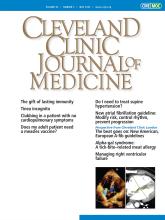
In this issue of the Journal, Rivard1 reviews and discusses some of the current guidelines for vaccination of patients against measles. Reading through the practical US Centers for Disease Control and Prevention recommendations for prevention of measles1,2 prompted me to reflect on the degree and perhaps surprising duration of immunity acquired from natural infection and the attenuated measles vaccine. Of historical interest is a detailed description by Peter Panum3 of a measles epidemic on the Faroe Islands in 1846. A prior measles outbreak occurred on the islands in 1781. Panum estimated that 5,000 of the 6,626 inhabitants in 1846 were infected, and at least 78 died. His notable observation was that the infection rate was fairly similar across age groups, with the exception that the elderly (age > 65, those who would have been alive during the 1781 epidemic) were spared. This seminal epidemiologic observation has since been corroborated with serologic data4 and extended to include data on the lasting serologic and clinical efficacy of the live attenuated measles vaccine.5 This can be contrasted with the recommendation that adults should receive booster vaccinations for tetanus and diphtheria every decade.6
The duration of efficacy of vaccines varies significantly depending on the type of vaccine, its structure, the age at which it is given, and, likely, the pathogen it targets. Studies have shown that the measles vaccine, which is a live attenuated virus, is highly effective, with a median effectiveness of 93% after 1 dose and 97% after 2 doses.1 The second dose in the usual regimen is not a “booster,” but it provides immunity to those who do not respond to the first dose. Although not necessarily lifelong for all individuals, measles vaccine–induced immunity is quite durable. This distinguishes the measles vaccine from some others. For instance, the tetanus and pertussis vaccines (nonreplicating antigen–containing platforms) typically require booster doses every 10 years to maintain full immunity. Other nonreplicating vaccines, like the hepatitis B vaccine, provide long-term protection, often lasting decades without the need for boosters. So it is not just live vs “dead” that dictates duration of efficacy.
The measles virus, and the attenuated live virus used in the measles vaccine, are enveloped, single-stranded RNA viruses. Unlike many RNA viruses, the measles virus and attenuated live virus are extremely stable, eliminating the need for periodic vaccine modifications as required for influenza and COVID. The attenuated live virus has multiple sequence differences from the native measles virus, resulting in decreased replication in immune cells, but the full explanation for its decreased pathogenicity and lasting immunity is not known.
The durability of immunity following natural infection with measles, and of the usually self-limited but occasionally severe general immunosuppression associated with acute infection (immune amnesia), may be based in the life cycle of the infecting virus. Initial infection is mediated by uptake of the virus by several different receptors into immune cells, first in the airways, including T and B lymphocytes, dendritic cells, and activated monocytes, some of which will transport the virus to lymph nodes around the body. Humoral and cell-mediated immunity are stimulated, and the prolonged presence of virus may drive the maturation of the specific humoral response while at the same time causing suppression of both delayed hypersensitivity to recall antigens and humoral responses to preexisting nonmeasles antigens.7 This “immune amnesia” may last several years and predispose affected patients to other infections, a contributor to the morbidity of measles infection. Interestingly, the attenuated measles vaccine does not induce this immunosuppression,8 possibly due to decreased infection of immune cells compared with the natural measles virus.9
The long-lasting antimeasles immunoglobulin G antibody response is protective against reinfection, while the cell-mediated antivirus response is required to abrogate the active infection. The measles virus invades and replicates in airway columnar epithelial cells, resulting in desquamation of cells into the airway, which permits spreading of the virions and virus-infected cells through coughing and sneezing.
At present, there is no available potent antiviral treatment for measles. Given the durable efficacy of the available attenuated live measles vaccine and the lack of any nonhuman host or environmental reservoir, eradication of this disease is a potential reality.
For those interested in reading a well-referenced overview of the measles virus, I’d suggest looking at a paper by Moss and Griffin.10
- Copyright © 2025 The Cleveland Clinic Foundation. All Rights Reserved.






